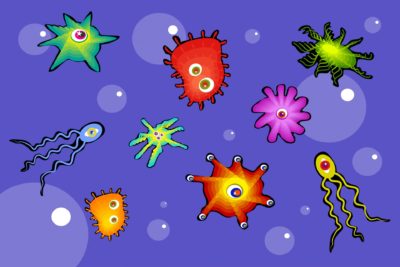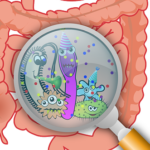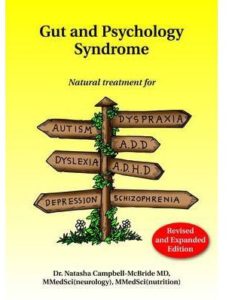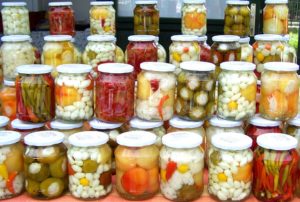Are Your Gut Microflora Doing the Happy Dance?


Did you know that inside your intestinal walls is a humongous community of microflora that largely determines your health? It’s true. While we think that the food we eat is just for us, we are really feeding a whole little world inside our guts that impacts our physical and mental health!
I was recently watching several of the online Microbiome Medicine Summit presentations where a number of different medical and holistic practitioners discussed the gut microbiome over a series of days. While I knew that the bacteria that reside in our gut are critical to our health and mental well being I was surprised to learn that in addition to bacteria, there are lesser populations of fungi, viruses, and protozoa residing in our intestinal tract which also play important roles in promoting good health. Together these microflora form the gut microbiota and their genes form the gut microbiome. It’s not just our genes that inform our health and well-being but, perhaps more importantly, the genes of the 10-100 trillion microbiota that reside in our intestinal tract.
I also learned that while the human genome is about 99% identical among individuals, 95% of gut microbiota varies depending on the individual’s geographic location. Through further research I discovered that, in general, there is also an 80-90% variation in the gut microbiota among individuals,[1] and that while the composition of the gut microbiota is largely influenced by diet, these microbes are interdependent, influencing the predominance and/or activity of others and, collectively, our health.[2]
Understanding the role of our microbiome, which is almost like another body organ, and keeping it in good shape are, therefore, very important keys to health and longevity. Although researchers are beginning to study other microbiota in depth, currently, it is the bacteria with which we are most familiar and have the most information.
Bacteria can be either helpful or harmful. Depending on a variety of factors, we may colonize more or less of different types. Beneficial bacteria prevent detrimental bacteria from proliferating; are instrumental in the brea kdown/digestion of our foods and turning their components into products our body can use; produce numerous vitamins, amino acids, and other active substances; support our immune system; and have a major impact on our moods and mental health. You might be surprised to learn that almost 90% of the “feel good” brain neurotransmitter serotonin is produced in the gut and that microflora are critical to sufficient production.[3]
kdown/digestion of our foods and turning their components into products our body can use; produce numerous vitamins, amino acids, and other active substances; support our immune system; and have a major impact on our moods and mental health. You might be surprised to learn that almost 90% of the “feel good” brain neurotransmitter serotonin is produced in the gut and that microflora are critical to sufficient production.[3]
Beneficial bacteria are introduced to a baby’s system as it travels down the birth canal and in the breast milk it drinks (there are bacteria in both) in order to populate his/her gut with balanced, healthy microflora that should ideally last a lifetime. (Some formula manufacturers have begun adding probiotics to their formulas.)
Unfortunately, a number of different factors negatively affect gut flora, causing detrimental bacteria to proliferate or a reduction in the number and diversity of bacteria, resulting in improper or incomplete breakdown of foods, autoimmunity, inflammation, cancer, and unwanted psychological and behavioral symptoms.
Many of us take probiotics during and after a course of antibiotics thinking that this will put back the microflora the antibiotics have destroyed. However, studies such as the following have shown that antibiotics do long-term harm to our systems and sometimes these changes are permanent.
Antibiotics are mainly used to combat pathogenic bacterial species that reside within or have invaded a host, however the current generation of antibiotics are broad spectrum and target broad swaths of the normal microbiota as well. Thus, antibiotics significantly affect the host’s innate gut microbiota. Three to four days after treatment with the broad-spectrum antibiotic ciprofloxacin the gut microbiota experience a decrease in taxonomic richness, diversity, and evenness. The large magnitude of changes in the gut microbiota demonstrated significant interpersonal variability. While the gut microbiota began to resemble its pre-treatment state a week after treatment, differences between individuals were seen with regards to how closely the post-treatment community resembled the pre-treatment community, and some taxa failed to return to the community. Indeed, the reestablishment of some species can be affected for up to four years following antibiotic treatment.[4]
 Dr. Natasha Campbell-McBride, in her book Gut and Psychology Syndrome (GAPS), discusses the role that not only antibiotics, but other drugs, poor diet, disease, stress, and other factors play in negatively affecting gut microflora. And she points out that these negative influences on the gut microbiome have a far greater affect than most of us have ever imagined:
Dr. Natasha Campbell-McBride, in her book Gut and Psychology Syndrome (GAPS), discusses the role that not only antibiotics, but other drugs, poor diet, disease, stress, and other factors play in negatively affecting gut microflora. And she points out that these negative influences on the gut microbiome have a far greater affect than most of us have ever imagined:
Every one of us carries a unique mixture of microbes in the gut. Under the influence of drugs and other factors… this gut flora will be changed in a unique way in every one of us, predisposing us to different health problems… This damage gets passed from generation to generation as a newborn child gets its gut flora from the mother. And as the damage is passed through generations, it gets deeper and deeper.[5]
So what are we to do if we want to maintain (or regain) our health and that of our children and pass down a better heritage to future generations? While individuals with specific digestive issues such as SIBO and IBS may have disease specific requirements and others may need a diet such as Campbell-McBride’s GAPS diet, most of us can make some (relatively) simple adjustments to our diets to get on the right track.
One of the easiest ways of populating your intestinal tract with beneficial bacteria and other microflora (and as Weston Price  discovered has been an important part of the diet of most indigenous and traditional populations and cultures) is by eating fermented foods. Foods fermented by natural yeasts and bacteria in the air produce a multitude of beneficial bacteria, and increase the food’s nutritional profile. Since they are partially pre-digested through the fermentation process they are also easier for you to digest. These foods include not only the yogurt, cucumber pickles, and sauerkraut with which we are most familiar, but other pickled vegetables like beets, carrots, and garlic, beverages like kefir and kombucha, and sourdough breads. (Commercial sauerkraut and pickles, unless kept in the refrigerator section of the supermarket, are most likely pickled in vinegar and heated, so they are not fermented foods.)
discovered has been an important part of the diet of most indigenous and traditional populations and cultures) is by eating fermented foods. Foods fermented by natural yeasts and bacteria in the air produce a multitude of beneficial bacteria, and increase the food’s nutritional profile. Since they are partially pre-digested through the fermentation process they are also easier for you to digest. These foods include not only the yogurt, cucumber pickles, and sauerkraut with which we are most familiar, but other pickled vegetables like beets, carrots, and garlic, beverages like kefir and kombucha, and sourdough breads. (Commercial sauerkraut and pickles, unless kept in the refrigerator section of the supermarket, are most likely pickled in vinegar and heated, so they are not fermented foods.)
Another way of improving your microbiome is by taking a good quality probiotics containing a large variety of beneficial bacteria. Another presenter at the summit enumerated some of the important bacteria to look for in quality probiotics, noting the different influences on health for some of them:
- Bacillus coagulans – reduces abdominal bloating and gas
- Saccharomyces boulardii – reduces inflammation, elevated TNF Alpha, and Interleukin 6
- Acidophilus rueteri
- Biffidobacterium lactis – alleviates constipation and diarrhea
- Lactobacillus Roselle 52 – breaks down hard-to-digest fibers
- Lactobacillus rhamnosus
- Lactobacillus Casei Roselle 215 – makes enzyme that helps breakdown lactose
The following bacteria can be instrumental in alleviating depression, anxiety, and brain fog
- Lactobacillus helveticus
- Lactobacillus plantarum ps128
- Biffidobacterium infantis
- Biffidobacterium longum
In addition to positive lifestyle changes such as reducing stress and getting adequate sleep, the best ways to support intestinal (and overall) health is by eating a varied diet of good-quality nutrient-dense foods. In addition to eating fermented foods, there were many other dietary principles that the populations that Price examined adhered to that were important to maintaining a well functioning digestive system, overall good health, and a cheerful disposition. Thanks to Price’s research, we can incorporate these principles into our diets as well. Read about them here.
For sources of probiotic/fermented foods and natural and organic products in Israel click here.
Notes:
[1] Defining the Human Microbiome
[2] Archaea and Fungi of the Human Gut Microbiome: Correlations with Diet and Bacterial Residents
[3] Microbes Help Produce Serotonin in Gut
[4] Defining the Human Microbiome
[5] Gut and Psychology Syndrome, pg. 38
Other Resources:
Lacto-Fermentation
Fast Facts About the Human Microbiome
What is the Gut Microbiota? What is the Human Microbiome?
Are Probiotics in Your Baby Formula?
The Best Probiotics for Mood: Psychobiotics May Enhance the Gut-Brain Connection
5 Simple Steps to Cure IBS Without Drugs
SIBO – Small Intestine Bacterial Overgrowth
I don’t know where I first heard this a few years ago, and I can’t say for sure that any changes made have been felt directly, but I decided to start using apple cider vinegar as much as possible in salad for example.
I also started drinking buttermilk every morning until I realized that it’s important to only use products that aren’t pasteurized unlike the buttermilk that I was drinking.
There are supposed to be a lot of positive health benefits for using apple cider vinegar (ACV)- the best ACV are the unpasteurized and unfiltered ones that have the “mother” in them – strands that are visible in the bottle, looking perhaps like sediment. The “mother” is composed of enzymes and important to the quality of the vinegar. The one that we found in Israel is from Naturafood and says that it is natural and organic, not pasteurized and not filtered with an acidity of 5%. It comes in a green bottle. Be careful since Naturafood also makes one that doesn’t have the mother in it. In the States, the company known for the best ACV is Braggs.
I mostly use it when I feel that my stomach acid is low and I need it to aid digestion or to help eliminate gas.
Yep, that’s the one. I now prefer it to white vinegar for the taste. Can’t stand that bottle shape though, slipped right through my hands once
Oy. What a mess that must have been! Have you tried red or white wine vinegar?
Great article, I’ve said for a while if we eat foods from the soil around us we get the microbes we need for the environment we live in. This support my theory.
Where can I buy Kefir in Israel? thanks!
Hi,
You can’t buy kefir in stores here as far as I know (except perhaps Russian grocery stores?). Either people get the grains from someone else and make their own or find someone who is making kefir already and will sell/give them some.
You can ask on your local Yahoo group or on the Israel food and Israel Fermented Facebook groups.